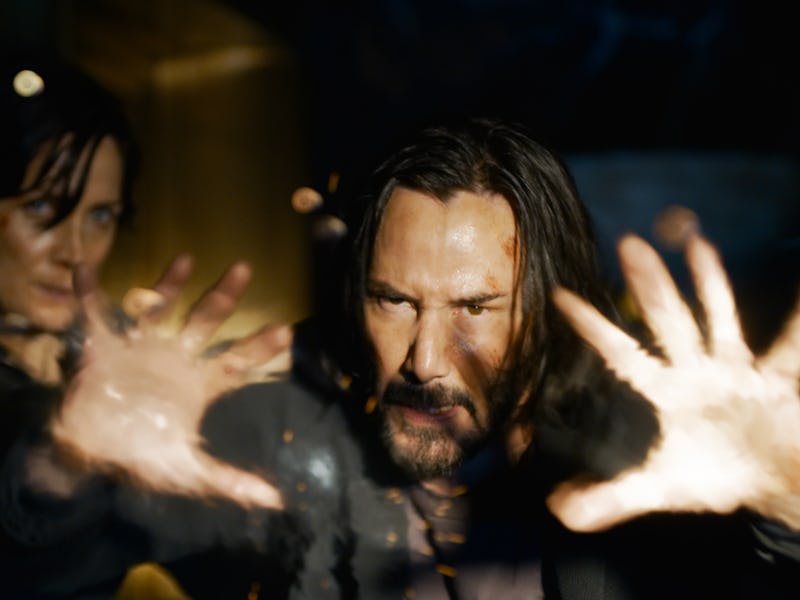Matrix 4 trailer explained: One sequels scene reveals Resurrections' twist
After sacrificing himself to end the threat of Agent Smith, Neo returns. But how?

“Just how long do you think this peace is going to last?”
“As long as it can.”
That’s how The Matrix Revolutions ended, just shy of two decades ago. While both Matrix sequels remain divisive entries in the franchise, to put it mildly, there’s electricity in the air today, with Warner Bros. releasing a trailer for the upcoming The Matrix Resurrections, which picks up the story for a fourth entry.
Though in some ways a spiritual remake of the original Matrix from 1999 — right down to the choice of color-contrasted pills — Resurrections will also serve as a continuation of the trilogy, with both Keanu Reeves and Carrie-Anne Moss back as Neo and Trinity.
But how does Resurrections carry on the story? And, hey, didn’t Neo die? As many of us scramble to remember what actually happened in those Matrix sequels (did I mention they were unpopular?), Resurrections gives fans plenty of reasons to go back down the rabbit hole.
Though The Matrix is unforgettable in broad strokes, its finer details may be a little hazier in your memory. But rest assured: the film’s sequels did in fact set up The Matrix Resurrections, nearly 20 years ago. Here’s how.
At the end of The Matrix Revolutions, the Matrix rebooted after the sacrifice of Neo. So how is Neo still alive?
“This is the sixth version”
To this day, one of the biggest twists in 2003’s The Matrix Reloaded remains that it swerved on the first film’s “chosen one” narrative. While the first film channeled the aesthetics of late ‘90s punk and nascent Internet subcultures to tell a universally relevant tale of one man’s sci-fi enlightenment (think of Neo as a wide-eyed college student and Morpheus as his first “cool teacher”), The Matrix Reloaded revealed that Neo’s role as a revolutionary was nothing more than predetermined programming, a maneuver enacted by the Matrix itself.
To use another metaphor: Neo was about as punk-rock as buying a shirt at Hot Topic.
The main misstep in Reloaded that poisoned the trilogy was that it dumped all of the most necessary exposition about Neo, the Matrix, and the function of “The One” into a single scene. Neo meets the Architect (Helmut Bakaitis), who brings into Reloaded a restrained presence, inert five-dollar vocabulary, and sleep-inducing monotone delivery. The scene’s sleepily directed, with straightforward staging and many screens surrounding the Architect in what feels like a prioritization of metaphor over explanation.
At the end of Revolutions, Neo arranged a truce with the Machines to exterminate Agent Smith, who posed a threat to all of them.
And yet, this moment provided all the information audiences needed to know about the Matrix: namely, that Neo was not one of a kind but a sixth iteration. As “The One,” Neo’s role was to “return to the source,” safely rebooting the Matrix. From there, Neo would select the next person to be “The One,” and the cycle could continue. Even the threat of Zion wasn’t really at stake. The machines had destroyed Zion five times before, and they’re getting better at it every time.
What unfolded in Revolutions, the third entry, was truly an inevitability. Neo brokered a truce with the machines to get rid of the malignant rogue Agent Smith (Hugo Weaving), sacrificing himself in the process. His death allowed the Matrix and the real world to both be free from the threat of Agent Smith; in exchange, the machines agreed to end their campaign against Zion. Neo died, and the world — both real and artificial — carried on.
And now, a Resurrection
As if the existing Christ metaphors didn’t apply to Neo enough already, “Resurrections” is a curious choice of words to title this next installment.
The Matrix Resurrections resembles, in a lot of ways, that first Matrix, a game-changing release that set the tone for genre-bending blockbusters across the next two decades. The plot again concerns Neo’s “awakening” in a world he feels detached and alienated from. He is once again compelled to face an uncomfortable truth about his reality, prompted by Morpheus (or someone like Morpheus; the specific details of Yahya Abdul-Mateen II’s role remain unknown) via a choice of pills.
But Resurrections, this time directed solely by Lana Wachowski, is shaping up to take on Hollywood’s obsession for “reboots” in the same way it challenged “chosen one” narratives that were popularized by films like Star Wars and The Terminator. (Harry Potter, now the definitive version of that narrative archetype, arose between The Matrix and its sequels.)
We like fresh ideas but the comfort of things that are familiar, too. The Matrix Resurrections is looking like a gripping, arresting delivery of that paradoxical desire: It’s not new, but it is a fresh start. That’s quite fitting with the story of the Matrix and its hacker-influenced ideas: It is a universe that is inherently designed to be rebooted.
There have been some necessary changes in Resurrections, none of which seem to arrive out of nowhere. The artificial world of the Matrix has exchanged its previously dull, pale-green palettes for a rainbow of colors, itself a potential direct tie to the end of 2003’s Revolutions that saw a rebooted Matrix drenched in a vibrant morning sun.
For now, we can only guess at the finer details of how Neo came to forget his role as The One, how he’ll remember Trinity, and why Morpheus, now played by Yahya Abdul-Mateen II, has been reborn. (Remember The Matrix Online from 2005, in which Morpheus was unceremoniously killed by a masked assassin? That’s still canon.)
These plot points will certainly be addressed when Resurrections actually comes out. Until then, just remember: This was supposed to happen. It was programmed that way.
The Matrix Resurrections will be released in theaters and HBO Max on December 22.